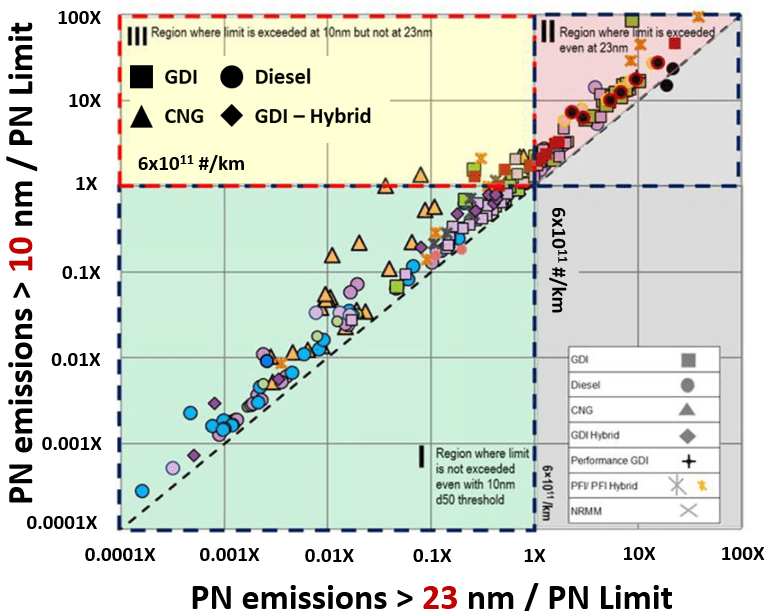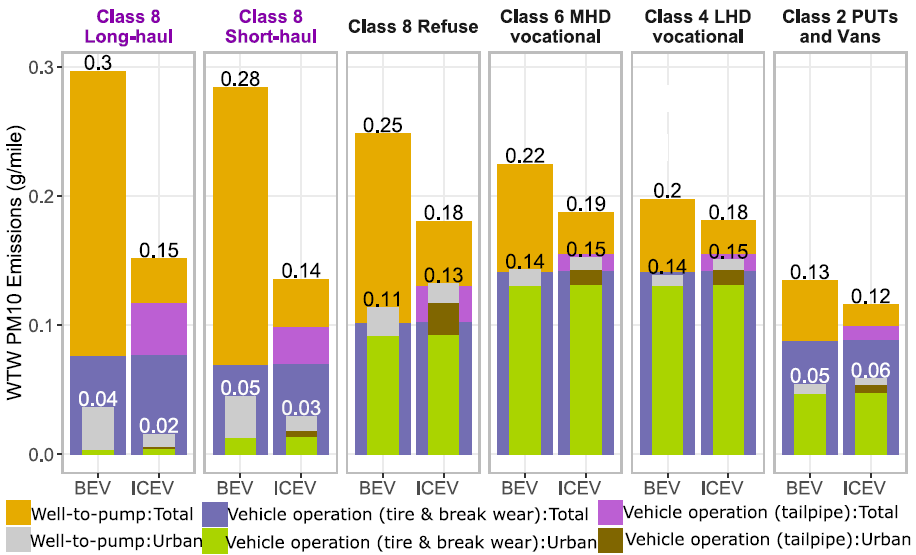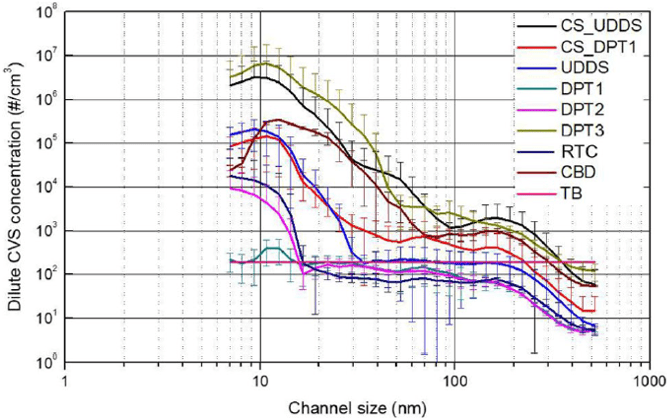Preparing for Euro VII : Sub-23 nm particles
Background
Starting with Euro 7 (or Euro VII for heavy-duty), the next phase of regulations in Europe for passenger cars and heavy-duty trucks, tailpipe limits on particulate emissions are expected to get tighter. Current regulations allow emissions of 600 billion particles per kilometer for cars or per kilowatt-hour of work done for trucks. Typically successive regulations reduce the limits on particulates and other and accordingly this limit could decrease in Euro 7.
But another change coming is that particles down to 10 nm will be counted and regulated, a change from the current cut-off of 23 nm, reflecting both the increasing awareness of health impact due to ultra-fine particles and also improved measurement capabilities.
The figure on the right shows extensive measurements done through a joint collaborative effort in Europe across a broad range of vehicles. The upper left quadrant shows the region where vehicles would pass Euro 6 but fail Euro 7 regulations due to excessive sub-23 nm particles. Clearly, these are not many, since adoption of filters already addresses the sub-23 nm particles very well. Still, this is an important step forward in ensuring that emission of some of the finest particles are greatly reduced.

Adapted from Samaras, Z.C., Andersson, J., Bergmann, A., Hausberger, S. et al., “Measuring Automotive Exhaust Particles Down to 10 nm,” SAE Technical Paper 2020-01-2209, 2020
We are moving to cleaner fuels and electrons, do particulate emissions matter?

From Liu, X., Elgowainy, A., Vijaygopal, R., and Wang, M., “Well-to-Wheels Analysis of Zero-Emission Plug-In Battery Electric Vehicle Technology for Medium- and Heavy-Duty Trucks,”
Environ. Sci. Technol. 2021, 55, 1, 538–546.
You know the answer to this one, they do.
Let’s address electrification first:
- As we have argued in this article, the on-road fleet today is so large that it eclipses any improvements in the new vehicles sold. Just in the US, we expect 120,000 tons of particulates to be emitted by passenger cars alone. Electrification will help shave off some of these, but we really need filters on all vehicles to make a significant dent.
- Moreover, while electrification is primarily a greenhouse gas play, without appropriate controls on the upstream electricity generation, the particle emissions problem is not solved. In fact, researchers at Argonne National Lab have shown that wells-to-wheel PM10 (that is particles < 10 microns) emissions will increase by 100% for all electric heavy-duty long haul trucks due to the high emissions associated with electricity production (which was 29% coal based for the 2019 US grid considered in the paper).
- Particles from non-exhaust sources, namely tires and brakes, are now higher than tailpipe and these are hardly affected by electrification. We will cover this in a future article.
Alternatives to diesels are being promoted for reduced NOx emissions, but these can also have unintended consequences with respect to particulates.
- Gasoline direct injected vehicles have elevated particle emissions similar to diesel and face a similar issue with sub-23 nm particles increasing the overall particle number count.
- Natural gas engines are very attractive for heavy-duty trucks : some of these are already certified to California’s 2027 ultra-low NOx standards, delivering greater than 90% lower NOx compared to diesels – while also offering improved fuel economy. However, natural gas engines especially have elevated emissions in the sub-23nm range, as shown by work done at UC Riverside, shown in this figure. These are not soot but are rather oil-derived particles, but harmful to human health nevertheless. (There are also elevated methane emissions to contend with, that is another topic to be covered later as well).
- In a recent paper based on a joint collaboration of Cummins, academia and instrument manufacturers, up to 8% higher PN was measured when using B20 fuel (20% biodiesel, 80% ultra-low sulfur diesel). More work will have to be done to understand the reason. On the other hand, various studies have shown that the addition of ethanol can help reduce both overall and sub-23 nm particles due to the increased volatility and therefore charge mixing, and reduced aromatics content (precursors to soot), displaced by the ethanol.

From Li, C., Han, Y., Jiang, Y., Yang, J. et al., “Emissions from Advanced Ultra-Low-NOx Heavy-Duty Natural Gas Vehicles,”
SAE Technical Paper 2019-01-0751, 2019
Is there a solution?
Yes. Particulate filters are increasingly making their way on all engine types which meet the European-style particle number standards. The good thing about filters is that filtration efficiency improves at very small sizes (due to increased Brownian motion of the particles at small size which leads to increased collisions with and trapping via the filter wall). Also injection systems are getting better and concentration of sub-23 nm particles and overall particle emissions have been shown to reduce at high injection pressures, due to improved fuel atomization and mixture formation.
Any other issues to be resolved ?
Several. Measuring particles down to 10 nm is not trivial and requires improved methodologies and advanced measurement equipment. While the regulations set a limit on solid particles, at sizes smaller than 23 nm, volatile particles can impact the solid count, and therefore need to be treated carefully.
An example is the overcounting of particles from diesel exhaust due to urea-based particles related to DEF (diesel exhaust fluid) dosing. The urea droplets ideally evaporate and decompose to deliver ammonia for NOx control using SCR technology. But some “particles” escape unconverted (or as nitrates and other products) and are detected downstream as solid particles. This issue has been studied in some detail by researchers at Southwest Research Institute and discussed in an SAE publication.
The existing “Particle Measurement Protocol” or PMP is being updated to recommend the best practices to be followed. An example is the use of catalytic strippers instead of evaporation tubes to better address the volatile particles.
Finally, we still need to continue to improve our understanding of how these ultra-ultra-fine particles interact with our bodies and the resulting health effects. So there is clearly more work to be done before we can – well – take a deep breath.
Check out the monthly newsletter covering the latest on sustainable transportation technologies and regulations. Sign up if you like such content.
Like it ? Share it !
Other recent posts
IRENA Renewable Energy Capacity Statistics 2025
![]()
According to the latest report from IRENA, 2024 saw the largest increase in renewable capacity, accounting for 92.5% of overall power additions.
CO2 Emissions Performance of Heavy-Duty Vehicles in Europe – 2022 Results
![]()
The European Commission has published the official 2022 CO2 emission results for heavy-duty vehicles. Many OEMs are ahead of the targets and have gained credits, while others have their work cut out as we approach the 2025 target.
A summary of the SAE 2025 OBD Conference held in Porto, Portugal
![]()
A summary of the SAE 2025 OBD Conference held in Porto, Portugal, provided by MAHLE Powertrain.

